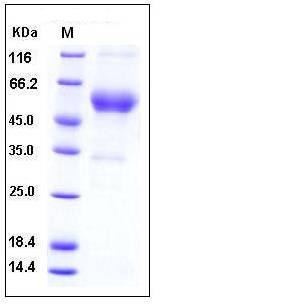Mouse ALK-1 / ACVRL1 Protein (His & Fc Tag)
Acvrlk1,AI115505,AI427544,Alk1
- 100ug (NPP2655) Please inquiry
| Catalog Number | P50208-M03H |
|---|---|
| Organism Species | Mouse |
| Host | Human Cells |
| Synonyms | Acvrlk1,AI115505,AI427544,Alk1 |
| Molecular Weight | The secreted recombinant mouse ALK1/Fc is a disulfide-linked homodimer after removal of the signal peptide. The reduced monomer comprises 345 amino acids with a predicted molecular mass of 39 kDa. As a result of glycosylation, it migrates as an approximately 50-55 kDa band in SDS-PAGE under reducing conditions. |
| predicted N | Asp 23 |
| SDS-PAGE |  |
| Purity | > 95 % as determined by SDS-PAGE |
| Protein Construction | A DNA sequence encoding the mouse ALK1 (NP_033742.2) precursor (Met 1-Pro 119) was fused with the C-terminal polyhistidine-tagged Fc region of human IgG1 at the C-terminus. |
| Bio-activity | Measured by its ability to inhibit BMP9-induced alkaline phosphatase production by MC3T3E1 mouse chondrogenic cells. David, L. et al. (2007) Blood 109:1953. The ED50 for this effect is typically 60-300 ng/mL in the presence of 2 ng/mL of recombiant human BMP9. |
| Research Area | Cancer |Invasion microenvironment |Angiogenesis |Adhesion Molecules in Angiogenesis |Extracellular Matrix |Structures | |
| Formulation | Lyophilized from sterile PBS, pH 7.4 1. Normally 5 % - 8 % trehalose, mannitol and 0.01% Tween80 are added as protectants before lyophilization. Specific concentrations are included in the hardcopy of COA. |
| Background | Activin A receptor, type II-like 1 (ACVRL1), also known as ALK-1 (activin receptor-like kinase 1), is an endothelial-specific type I receptor of the TGF-beta (transforming growth factor beta) receptor family of ligands. On ligand binding, a heteromeric receptor complex forms consisting of two type II and two type I transmembrane serine/threonine kinases. ACVRL1 protein is expressed in certain blood vessels of kidney, spleen, heart and intestine, serving as an important role during vascular development. Mutations in ACVRL1 gene are associated with hemorrhagic telangiectasia type 2, also known as Rendu-Osler-Weber syndrome 2 and vascular disease. |
| Reference |
